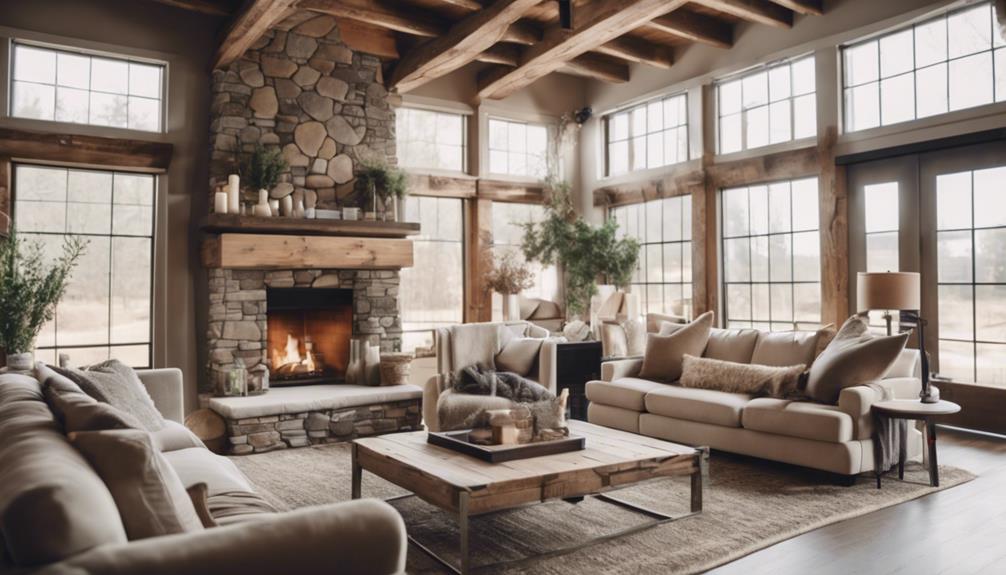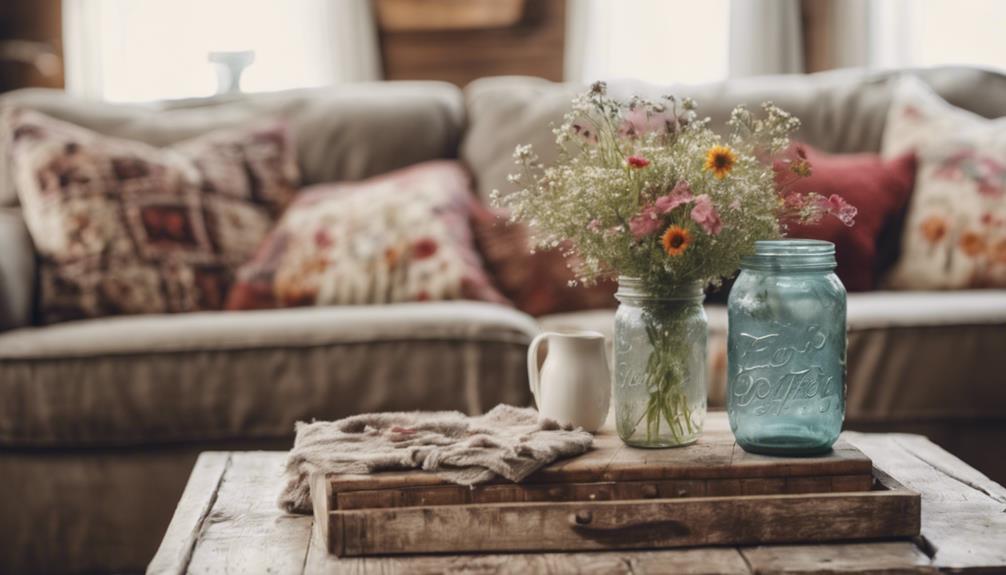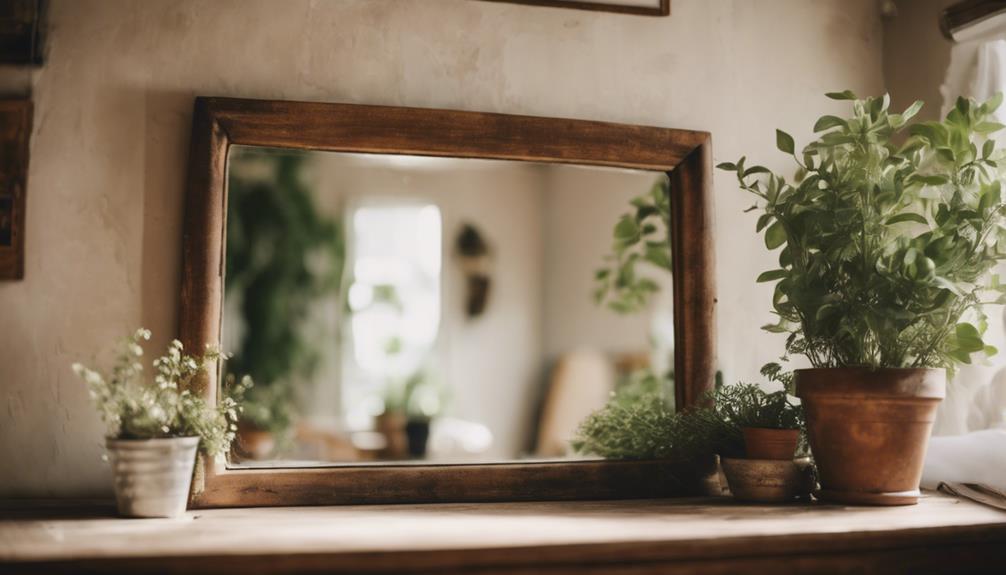The modern farmhouse interior beautifully combines elegance with comfort. You will appreciate the neutral color schemes of whites, creams, and soft grays, which create a light and welcoming atmosphere. Natural materials like reclaimed wood and shiplap add rustic charm while also maintaining functionality with clean lines. Cozy furniture, such as plush sofas and large gathering tables, encourages family time. Mixing textures with matte finishes enhances the warm feeling of the space. Don’t forget personal touches, like vintage decor and unique accessories, to truly make the space your own. For more tips and ideas to inspire your modern farmhouse journey, check out our resources.
Key Takeaways
- Embrace a neutral color scheme with whites, grays, and beiges to create a bright, airy atmosphere that exudes elegance.
- Incorporate natural materials like reclaimed wood and shiplap to enhance rustic charm and add warmth to your space.
- Choose comfortable, oversized furniture that encourages family gatherings while maintaining a stylish and inviting aesthetic.
- Mix textures and finishes, combining matte surfaces with polished elements for visual interest and a cozy atmosphere.
Characteristics of Modern Farmhouse Design
Modern farmhouse design combines the charm of traditional farmhouses with sleek, contemporary elements, creating spaces that feel both welcoming and stylish.
At the heart of this modern farmhouse style is a neutral color scheme featuring whites, grays, and beiges. This palette fosters a bright and airy atmosphere while maintaining that cozy farmhouse aesthetic you love.
You'll find natural materials, such as reclaimed wood and shiplap, adding rustic elegance to your interior. The design emphasizes clean lines and functionality, prioritizing practical furnishings that enhance spatial flow. Exposed beams often grace the ceilings, providing a touch of architectural interest and a nod to traditional craftsmanship.
A key characteristic of this design is its cohesive design approach, blending vintage and modern decor seamlessly. This mix allows you to personalize your space while ensuring everything feels harmonious.
Furniture choices are large and comfortable, inviting family gatherings and relaxation. In embracing these features, modern farmhouse design offers you a unique blend of comfort and style that's perfect for today's lifestyle.
Key Materials and Finishes

When designing your modern farmhouse, choosing the right materials and finishes is essential.
You've got to focus on natural elements like reclaimed wood and matte surfaces that enhance the cozy yet polished vibe.
Mixing textures, such as shiplap and distressed finishes, will add depth and character to your space.
Natural Material Selection
Natural materials like reclaimed wood and linen play a crucial role in creating the inviting atmosphere that defines modern farmhouse interiors. By using these materials, you can achieve an organic feel that brings warmth and character to your space.
Reclaimed wood, for instance, adds rustic wood accents that aren't only stylish but also sustainable, making them perfect for modern farmhouse design.
Incorporating farmhouse sinks into your kitchen enhances functionality while contributing to the overall aesthetic. Pairing these sinks with unique fixtures, like oversized pendant lights or rustic sconces, elevates the charm of the room.
To maintain a cohesive look, opt for finishes that emphasize matte textures. These low-shine materials strike a balance between sophistication and casual appeal, making your home feel both elegant and comfortable.
Don't shy away from mixing high and low materials, such as industrial metals alongside warm wood elements. This combination creates a relaxed vibe that captures the essence of modern farmhouse design.
With the right selection of natural materials, you can transform your space into a welcoming retreat that reflects your personal style.
Matte Finish Appeal
Embracing matte finishes in your home design not only enhances the cozy atmosphere of a modern farmhouse but also highlights the beauty of organic materials. These finishes create a sophisticated yet casual vibe, balancing elegance and comfort. You'll find that applying matte white paint on walls and furniture contributes to the airy, bright feel typical of modern farmhouse interiors, ensuring a clean aesthetic.
Adding matte-finished fixtures, like faucets and lighting, provides a contemporary touch while seamlessly blending with rustic elements. This approach fosters a cohesive design that emphasizes the natural textures and organic materials so essential to modern farmhouse decor.
| Material Type | Matte Finish Benefits | Examples |
|---|---|---|
| Wood | Reduces glare and enhances warmth | Matte-finished cabinetry |
| Metal | Adds sophistication and modernity | Matte faucets and light fixtures |
| Textiles | Softens the space and adds comfort | Matte upholstery fabrics |
| Paint | Brightens spaces with a clean look | Matte white wall paint |
| Accessories | Complements rustic elements | Matte vases and decor items |
Mixing Textures Strategically
Mixing textures strategically in modern farmhouse interiors invites warmth and comfort, creating a layered atmosphere that feels both inviting and sophisticated. To achieve this, combine materials like reclaimed wood, soft linens, and matte metals.
Incorporating natural fibers such as jute or hemp in your rugs and throws enhances the rustic aesthetic while adding a tactile contrast to smoother surfaces like marble countertops or sleek cabinetry.
Using varied finishes, like matte and low-shine elements, helps strike a balance between sophistication and casual appeal, making your space feel more cohesive. Pair rough textures, such as exposed brick or distressed wood, with polished elements like glass or lacquered surfaces to create visual interest and depth.
This combination not only enriches the design but also elevates the overall ambiance. Emphasizing craftsmanship through unique finishes and artisanal pieces allows you to blend old-world charm with modern elegance seamlessly.
Furniture and Decor Choices
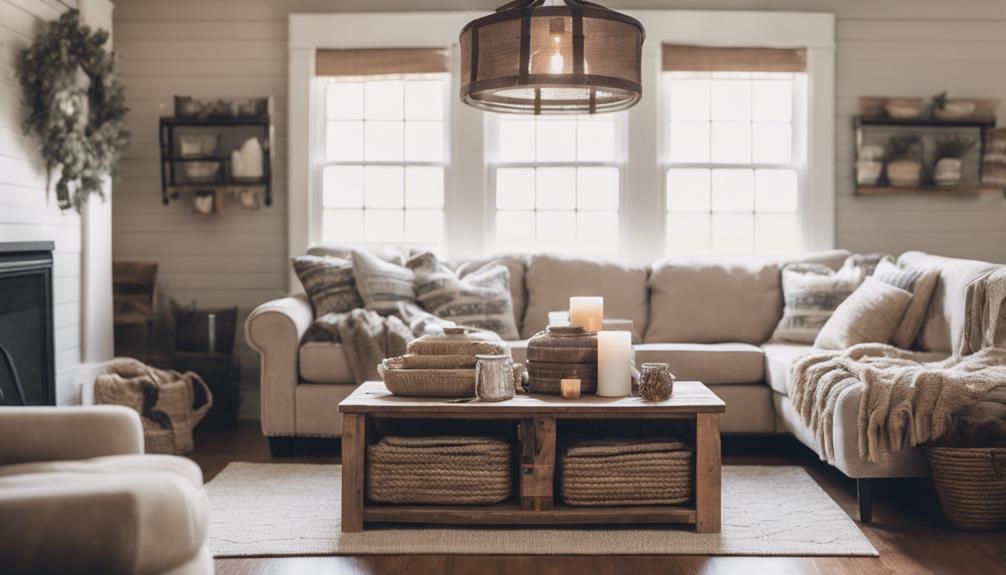
In modern farmhouse interiors, you'll find a harmonious blend of comfortable rustic furniture and sleek contemporary styles that create inviting and functional spaces. Your furniture and decor choices should focus on combining textures like wood, metal, and fabric to enhance the overall aesthetic. Opt for classic contemporary sofas in neutral shades, which prioritize comfort and seamlessly blend into the design.
Here's a quick overview of key furniture and decor elements:
| Furniture Type | Material | Decor Style |
|---|---|---|
| Farmhouse Table | Reclaimed Wood | Rustic Charm |
| Plush Seating | Soft Fabrics | Cozy Atmosphere |
| Wrought Iron Accents | Metal | Industrial Touch |
| Vintage Accessories | Mixed Materials | Eclectic Appeal |
Incorporating farmhouse furnishings like large tables encourages communal living, making family gatherings feel warm and inviting. Remember to play with various textures; the combination of wood and white elements adds depth to your modern farmhouse interior, ensuring a comfortable yet stylish environment.
Lighting and Ambiance
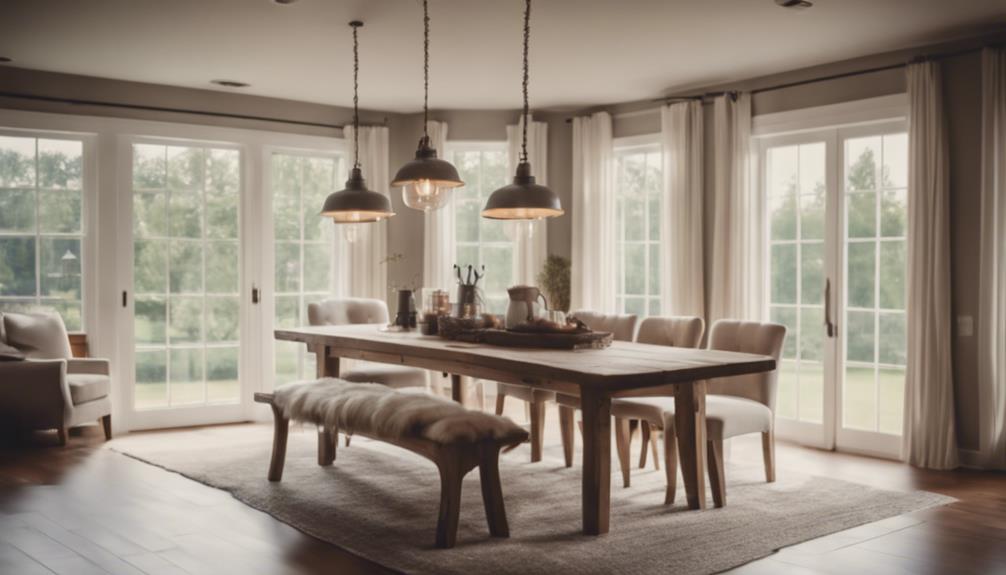
Creating the right lighting and ambiance in modern farmhouse interiors can transform your space into a warm and inviting retreat. By carefully selecting and layering your lighting, you can achieve a cozy atmosphere that feels welcoming.
Here are four key elements to take into account:
- Statement Light Fixtures: Choose rustic chandeliers or oversized pendant lights to serve as focal points in your kitchen and dining areas. They add character and elegance to your design.
- Natural Light: Maximize natural light by using large windows and sliding doors. This connection to the outdoors promotes an airy, bright feel in your home.
- Layered Lighting: Incorporate ambient, task, and accent lighting. Utilize dimmer switches to adjust the ambiance, making your space versatile for both functional and intimate settings.
- Decorative Lighting: Add candles and decorative lighting elements throughout your space. These touches enhance the relaxing mood, making your interiors feel even more inviting and homey.
Color Schemes and Textiles

In modern farmhouse design, you'll want to focus on soft neutral palettes that create a welcoming atmosphere.
Layering different textures and incorporating patterns like plaid or subtle florals will add depth without overwhelming the space.
Soft Neutral Palettes
Soft neutral palettes evoke a sense of tranquility and warmth, making them a perfect choice for modern farmhouse interiors. By incorporating these soothing colors, you can create an inviting atmosphere that enhances natural light and provides a cozy aesthetic.
Here are a few ways to effectively implement soft neutral palettes in your design:
- Choose Colors Wisely: Use warm and cool neutrals like cream, beige, gray, and white to establish a calming foundation.
- Incorporate Textures: Layer textures with materials such as wood and metal to add depth and visual interest while retaining a comfortable design.
- Add Accent Colors: Introduce soft blues and greens through textiles to bring personality and warmth without overpowering the neutral backdrop.
- Select Natural Fabrics: Opt for materials like linen and cotton in soft tones, enhancing both comfort and style in your modern farmhouse design.
Layered Textures and Patterns
Layered textures and patterns breathe life into modern farmhouse interiors, enhancing the overall aesthetic while maintaining a cozy atmosphere. You can achieve this by mixing materials like wood, metal, and soft fabrics, creating depth and visual interest. A neutral color palette featuring warm and cool tones—such as creams, beiges, and soft greens—promotes a soothing environment and enhances natural light.
Incorporating textiles with subtle patterns, like plaid or floral designs, can add character without overwhelming your space. Just remember to use these patterns in moderation to keep the look balanced. You can introduce accent colors through cushions, throws, and artwork, which provide personality and warmth to the otherwise neutral backdrop.
Consider combining various textures, such as a plush area rug alongside woven baskets and linen curtains. This mix not only contributes to a cozy and inviting environment but also embodies the essence of modern farmhouse style.
Personalization and Unique Touches
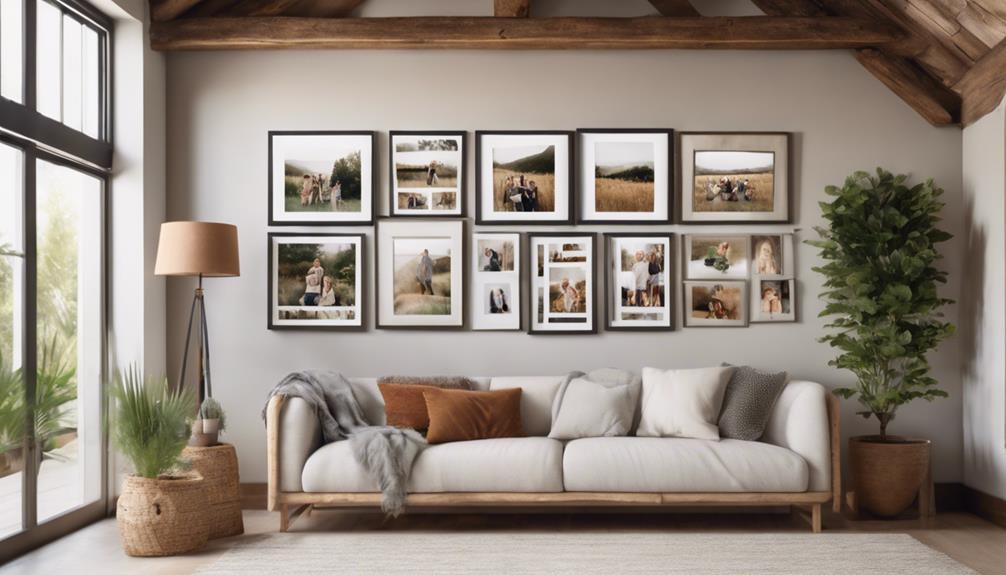
Personal touches transform modern farmhouse interiors into a reflection of your unique story and style. By incorporating elements that resonate with you, your space becomes a warm, inviting haven. Here are some ideas to personalize your modern farmhouse decor:
- Personal mementos: Incorporate family heirlooms or travel souvenirs that spark nostalgia and enrich your home's character.
- Custom art pieces: Create or commission DIY projects that express your creativity and align with your lifestyle.
- Vintage accents: Mix in vintage finds with contemporary designs to foster an eclectic feel that showcases your personal taste.
- Thoughtful placement: Arrange handmade crafts and unique finds from local markets to guarantee each piece contributes meaningfully to the overall design.
Frequently Asked Questions
What Trend Is Replacing Modern Farmhouses?
You're seeing modern cottages take over, with their cozy, eclectic styles. Vibrant colors and a mix of vintage pieces create warmth, shifting away from the traditional farmhouse aesthetics you might be used to.
What Defines Modern Farmhouse Interior Design?
Modern farmhouse interior design feels like a warm hug, blending rustic charm with contemporary flair. You'll find neutral palettes, natural materials, and cozy furniture that prioritize comfort, creating an inviting, functional space for relaxation.
Is Modern Farmhouse Still in Style in 2024?
Yes, modern farmhouse style's still in vogue for 2024. You'll find its blend of comfort, natural materials, and personalized decor choices appeals to many homeowners, making it a timeless choice for contemporary living.
What Color Furniture Is Modern Farmhouse?
In modern farmhouse design, you'll find furniture in neutral colors like whites, grays, and beiges. Earthy tones add warmth, while soft fabrics enhance comfort, creating an inviting and stylish atmosphere in your space.
How Can a Modern Farmhouse Kitchen Design Contribute to an Elegant and Comfortable Interior?
A modern farmhouse kitchen blend style functionality can contribute to an elegant and comfortable interior by combining sleek, modern design elements with rustic, cozy accents. The mix of clean lines and natural materials creates a welcoming atmosphere while offering practical features for cooking and entertaining.
Conclusion
Embracing modern farmhouse design isn't just about aesthetics; it's about creating a space that feels like home.
As you blend elegant finishes with cozy textures, you'll find that each choice reflects your personality.
Coincidentally, it's often in those little details—a handpicked vase or a reclaimed wood table—where the heart of your home truly shines.
So, go ahead and personalize your space; after all, a home is more than just a collection of beautiful things—it's where memories are made.
